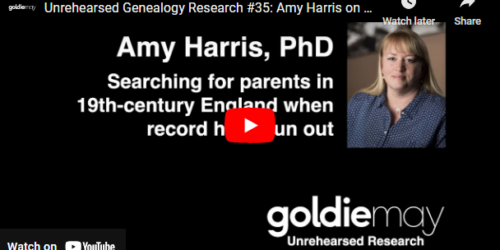The fundamental issue with historical research (including genealogical research) is accuracy. How do you establish trust in the conclusions of a historical (i.e. genealogical) researcher? For the purposes of this post and from this point on, I will focus on genealogical research as a subset of historical research in general.
Genealogical research relies entirely upon preserved and available historical records. Any record of events that includes information about individuals or families constitutes a potential genealogical record. It is tautological to state that the accuracy of genealogical conclusions relies entirely upon the accuracy of the original historical documents upon which the conclusions are based. Despite being tautological, much of what is recorded as “facts” about individuals and families is supported only by blindly accepting the accuracy of records that in and of themselves may not be accurate or is unsupported by any historic source or what is even worse, entirely lacks any reference to the source of the information.
The most easily understood example of ignoring the accuracy of records is the blind acceptance of previously compiled family history much of which in contained in personally published family history books, old piles of family group sheets and pedigree charts, Personal Ancestral File data, and GEDCOM Files. On the FamilySearch.org website, much of this information is preserved in the vast Ancestral File collection of the same material. It is also important to note that the Ancestral File went into the initial seeding of what we have as the FamilySearch Family Tree. Of course, some of this information is accurate and valuable, but wholesale copying ignore the need to verify the information with actual historical sources.
Let’s start with some examples of what is and what is not an accurate record. Suppose that I find three birth records for the same named individual all of which contain different birth dates. My first response to this situation should be to question whether or not the records refer to three different individuals with the same name or are the same person with only one of the records being accurate. But let’s further suppose that all three records appear to pertain to the same family. Which of the records, if any of them, is accurate. Now, let’s suppose that these same records date back to the early 1800s in England. The explanation may not lie with the accuracy of the records at all, the real issue may be that when a child died in a family, the child’s name was sometimes applied to subsequently born children of the same sex. This could happen two or even three times in the same family. So each of the seemingly contradictory records really apply to three different children. Further research may show that two of the children or even all three died at a very young age. Before the research is done to find the death dates of all three of the children, any entry showing less than all three or even all three would be inaccurate. But what is most likely to happen is the that each of the records was recorded without the knowledge of the other two. Individual use of the records would be correct but not complete.
This example illustrates two different aspects of genealogical research, reliance on the historical record and understanding and interpreting the record in its historical context. At the most basic level, accuracy is merely the function of copying and integrating the information correctly. I have found that I can transpose the numbers in a date or spell the name differently than it appears in the historical document. However, we need to be aware that these same “scrivener’s errors” occur regularly in historical documents. In Proverbs 11:14 it states:
Where there is no counsel, the people fall; But in the multitude of counselors there is safety.
I can paraphrase this quote as “where there is no historical source the research fails. But in a multitude of historical sources there is safety and accuracy.”
A fairly high percentage of the entries that I see in online family trees do not have any citations to the sources where the information was obtained. Another huge percentage have only one citation. The degree of accuracy or the reliability of the information recorded is directly related to the cited sources supporting that information. Information in a family tree without a cited source is ipso facto unreliable and questionable. However, long lists of sources do not help when then the records cited do not happen to contain the information entered into the individual’s entry. For example, the issue of whether a person’s parents have been correctly identified can be supported by a source record showing a parent/child relationship. Absent such a record, no matter how many other records are attached as sources, there is no support for adding parents for that individual.
We all find that historical records disagree about the same events. When those apparent disagreements are not due to the historical context, we have to keep searching until we find enough information to make a validly supported conclusion. In some case, we will inevitably find that we never resolve the lack of supporting information. In this case, we need to freely admit that we lack the information we need to draw a conclusion. What happens frequently in the context of online family trees is that individuals rely more on the reputation or believed reputation of the person supplying the information rather than they do upon the lack of support for the accuracy of the information they may have inherited. In these cases, it is better to simply acknowledge that the provider of the information had limited resources and many not have been correct.
In any event, there is no excuse for entering information in a publicly available family tree that has not been found to be supported by consistent, contemporary, historical records.






